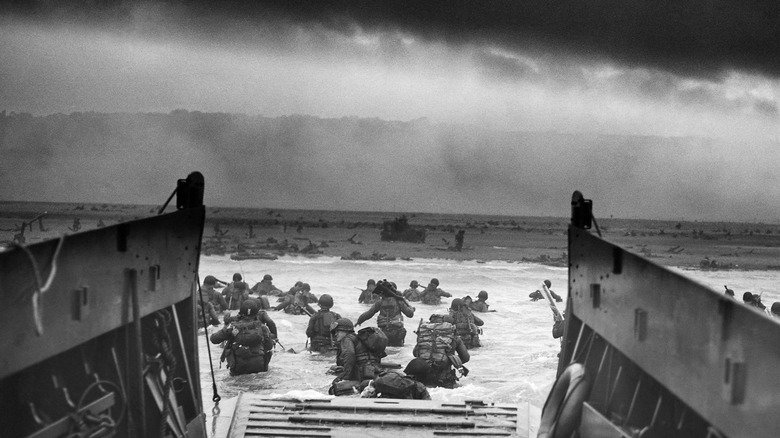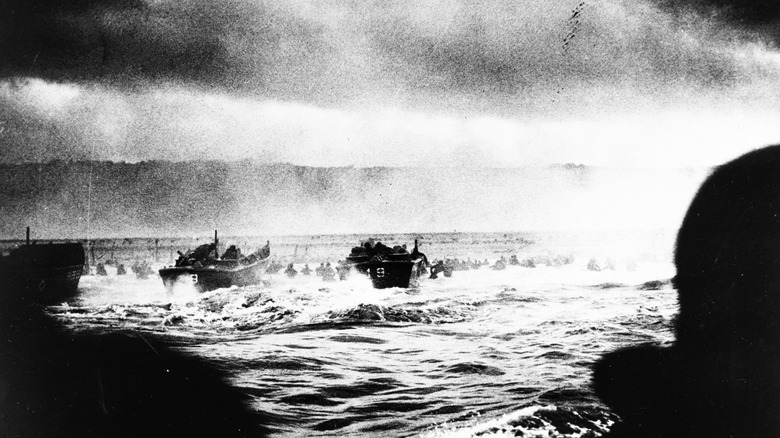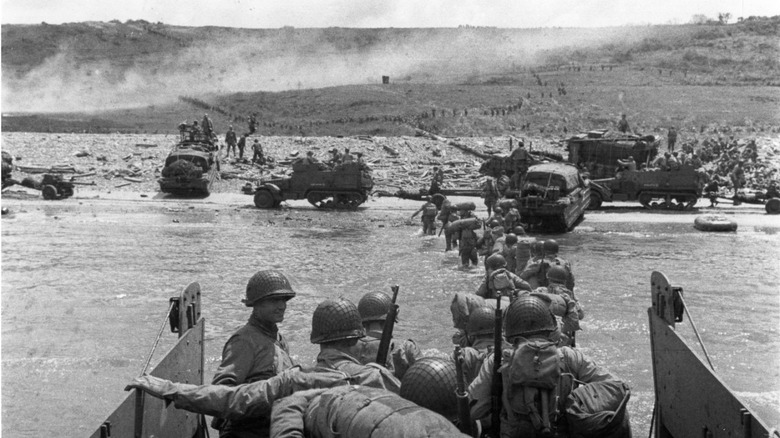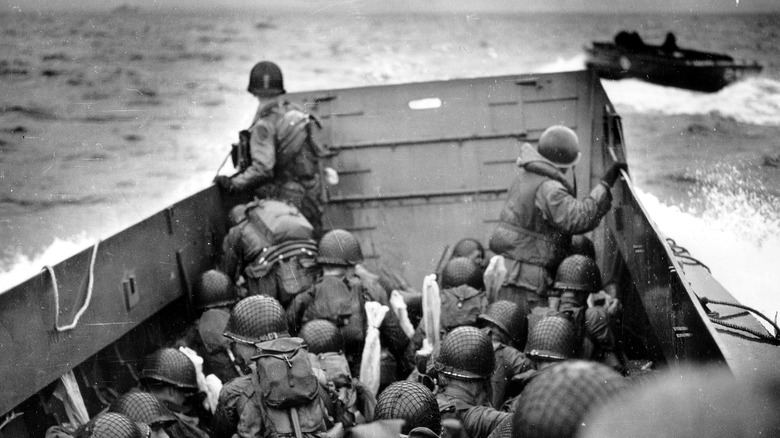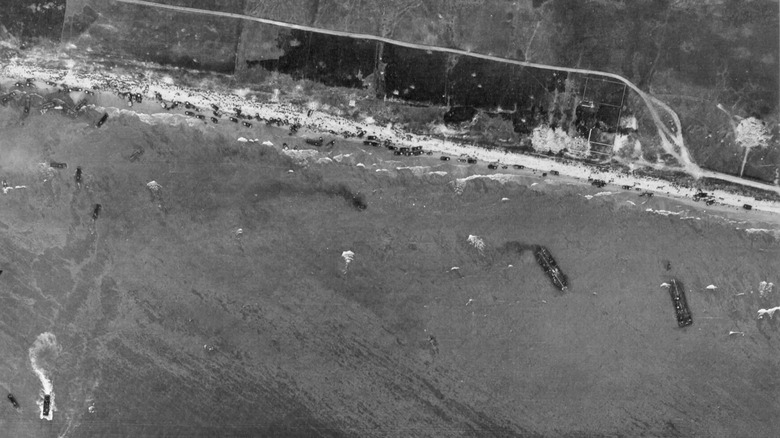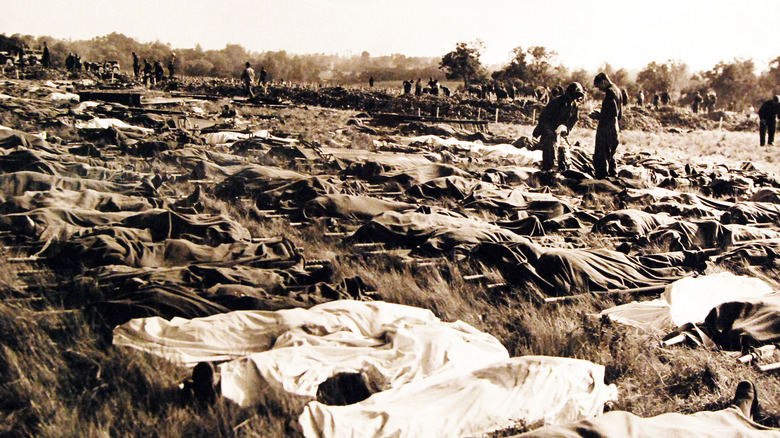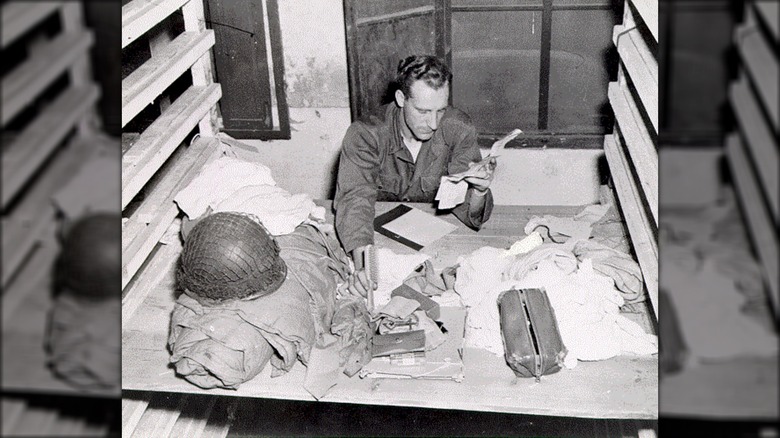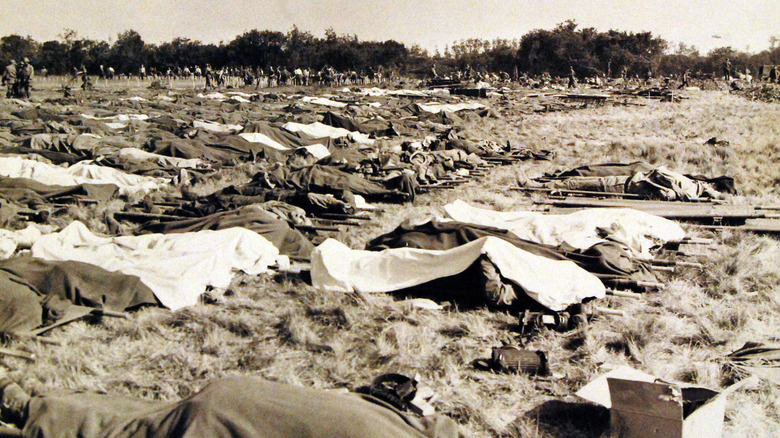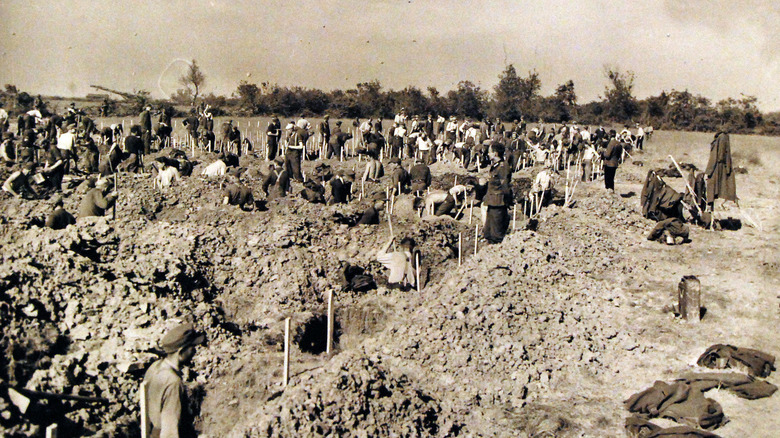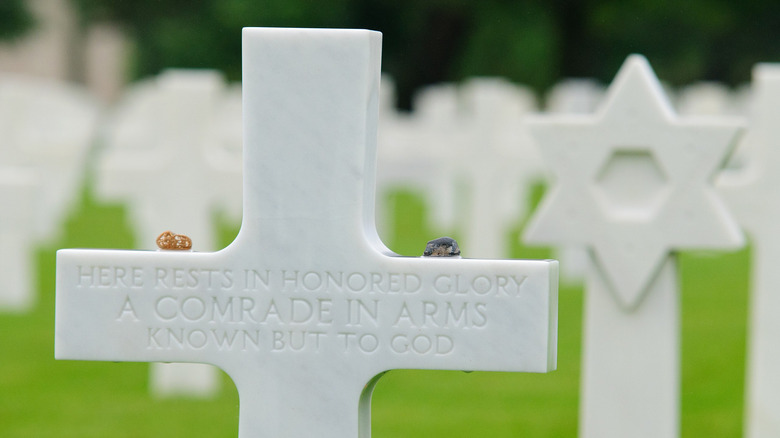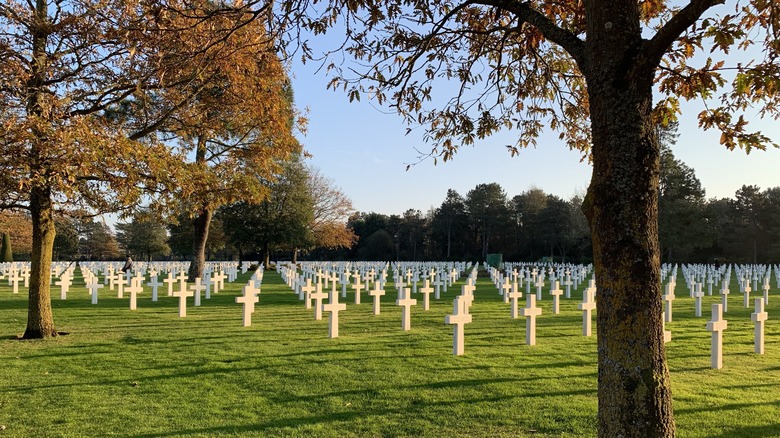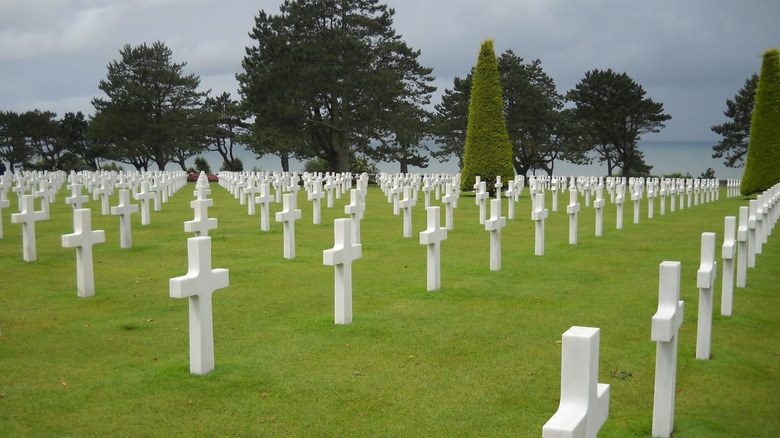What Happened To The Bodies From D-Day?
Though plans for D-Day had been building for years, nothing could quite prepare everyone for the reality of what the Allied takeover of continental Europe would mean for troops. According to the National World War II Museum, the first rumblings of what would be known as Operation OVERLORD, popularly called D-Day, began in 1942 but didn't materialize until the summer of 1944. The German High Command — that is, the Nazis — expected Allied troops to land elsewhere in France from nearby England, but officials had actually selected a 50-mile section of coast in the Normandy region. An estimated 160,000 soldiers were to land on five beaches, while airborne units would make landings further into France.
For American soldiers landing at the beaches codenamed Omaha and Utah, on June 6, 1944, German resistance was especially brutal. The terrain and weather further complicated the plan, sometimes pushing ships off course or forcing soldiers to wade through water while under fire. Still, Allied troops prevailed and won the day.
After D-Day, a practical but immensely difficult question remained: what to do with all of the bodies? Allied forces left behind thousands of their comrades' remains scattered across the beaches where they fell. The bodies were evidence of the devastating toll of the invasion. What's more, they had to be collected and buried in as respectful a manner as possible in a war zone. So, who took on this heavy task, and how exactly did they do it? Here's what happened to the bodies from D-Day.
Getting an exact number of D-Day fatalities is tricky
For as intensely organized as the D-Day invasion may have been to officials like Supreme Allied Commander General Dwight D. Eisenhower (via the National Archives), the experience for soldiers actually tasked with landing in Normandy could be chaotic. According to History, a combination of poor weather and intense German opposition not only made things confusing, but resulted in thousands of casualties. Ahead of the invasion, advisors told Eisenhower to expect a majority of the more than 150,000 soldiers to die in the attempt. For paratroopers in particular, they predicted an especially grim 75% mortality rate.
While it's clear that thousands of soldiers from both the Allied and Axis died that day, getting an exact number of fatalities has proven difficult. As History notes, it wasn't reasonable to expect commanders to carefully note when and where a service member died, especially if the individual ended up with a different company in the chaos. Moreover, missing soldiers were only declared dead a year after they disappeared, further adding to the confusion.
Today, most memorials claim that there were around 4,414 Allied deaths, with the worst casualties on Omaha Beach of about 2,000 U.S. soldiers. At other beaches along the Normandy coast, around 2,000 British service members were killed, along with an estimated 340 Canadian soldiers. German forces faced somewhere between 4,000 to 9,000 casualties, of which many fatalities were buried in the La Cambe German military cemetery (via TIME).
Some lay where they fell for a while
Because surviving troops were busy taking positions along the coast, the dead of D-Day were not always tended to in the moments after their deaths. To be certain, a dedicated group of graves registration soldiers would address the issue as quickly as they could, but no one expected them to be digging graves under heavy fire during the storming of the beaches. The best that a surviving soldier could do was to cover remains with a blanket or other cloth and move on. Many recalled the harrowing sight of remains floating in the water and fallen on the beach, with some places so full of the dead that surviving soldiers had to crawl on top of them (via PBS).
One famous photo shows Second Lieutenant Walter Sidlowski kneeling next to just such a draped body of a fallen comrade on Omaha Beach, with even more remains in the background. At first, the image may seem to have been taken in the midst of the action, but the National WWII Museum notes that it was actually shot a day later, on June 7.
First-hand accounts from military personnel who landed on the beach after the first wave include the harrowing sight of bodies in the surf and scattered across the sand. Artist Manuel Bromberg, who visited the scene three days after the landing, sketched the still-ongoing burial of soldiers on the beach, conducted by German prisoners of war (via Brown University).
Remains were also brought back to ships
Though many of the military personnel who approached the beaches of Normandy on June 6 did so with the intent to make it to land and push into Europe, some were expected to return to ships waiting farther back in the English Channel. Others remained on those ships to receive returning landing craft, as well as the wounded and dead soldiers who had been pulled back into the boats. One, Robert E. Davenport, was a naval intercept officer on the USS Henrico. As Davenport told USA Today, he and other ship-bound officers watched as smaller transports disappeared into the distance, on their way to take part in the landing on Omaha Beach.
When those boats returned, some of the landing craft carried the remains of soldiers who were killed by German guns before they even left the vessel. Other personnel, hampered by a sandbar that forced them to get out early and wade through the surf under heavy fire, were quickly wounded or killed. Some were then pulled back into the craft. Davenport recalled that the smaller boats would open their ramps to release water that had been taken on during landing. At the ship, that water sometimes ran red with spilled blood.
Back on the beach, soldiers recalled that bodies also frequently washed back onto the shore, adding to the already staggering number of remains that needed to be recovered and buried in temporary gravesites (via PBS).
Temporary graves were dug near the beach
As Allied troops successfully took German positions and gained control of the Normandy beaches, they had to move further into France and the rest of Europe. Paratroopers and other airborne forces had already landed further into the continent and would be working to meet them (via National World War II Museum). But, behind them along the coastline were thousands of bodies. Simply leaving them in the open where they fell was unacceptable, both for reasons of sanitation and morale. But neither did soldiers have the time to establish a formal cemetery for all of the dead.
So, as HistoryNet reports, temporary gravesites were quickly arranged. One man, Sgt. Elbert E. Legg, selected one such place. Without many supplies or equipment, he used whatever was available, including sections of wooden boxes to act as grave markers. Legg and his fellow servicemembers used parachutes left behind by paratroopers as shrouds.
Another servicemember, Pvt. Thomas J. Dowling recalled that, though they worked as hard as they could to bury remains quickly, decomposition was inevitable in the June weather. Trailers used to carry the dead from where they fell to burial grounds became unwelcome sights. Still, troops continued their work and established eight cemeteries in the area by June 10. A little more than a month after D-Day, those sites contained the remains of more than 30,000 individuals (via HistoryNet).
Graves registration was carried out by a dedicated group
As troops moved on from the beaches of Normandy and into northern France, thousands of the dead were left behind. But they weren't going to stay there for very long. Soon, the Quartermaster Graves Registration Service moved in.
As per the U.S. Army, burial practices for fallen service members in the earliest conflicts of the nation were haphazard at best. It wasn't until 1862 that a national cemetery system was authorized by Congress, and a further three decades before an organized burial and registration procedure was established by the army's Quartermaster Department. Chaplain Charles C. Pierce was behind many of these improvements, including soldiers' adoption of identification badges, more commonly known as "dog tags." These would often prove helpful when it came to identifying the dead at Normandy.
According to HistoryNet, members of multiple Graves Registration Companies were effectively drafted into their line of work. By the time they arrived in France, they had already undergone extensive training, from observing an autopsy to organizing mock burial grounds. Still, few were prepared for the trauma of collecting and burying so many remains, even if prisoners of war and civilians were also tasked with the hard labor of digging the graves. Further into Europe, Graves Registration representatives would also have to seek out the resting places of soldiers who had died in combat zones, in order to rebury their remains, inventory anything found with the individual, and mark the spot for future reference.
Graves registration troops took special care in identifying the dead
When it came to identifying the remains on the beaches of D-Day, it was sometimes as simple as looking for a pair of small metal tags worn around someone's neck. These "dog tags" were created by U.S. Army Chaplain Charles C. Pierce in the late 19th century and, decades later, were often worn by many WWII military personnel. According to the U.S. Army, Pierce also developed identification techniques that would be utilized by his successors in the Graves Registration Companies. These included careful detective work that pushed an investigator to gather every piece of information they could about an individual and their time and manner of death.
For remains found with identification tags, the standard practice was to bury the remains with one tag, while sending the duplicate back for registration purposes (via "The Graves Registration Service in World War II"). However, the chaos and bloodshed of D-Day did not always mean that bodies would be found with dog tags conveniently spelling out the deceased's name and company. Instead, some were forced to dig deeper in order to connect a body with an identity and a family back home.
Graves registration personnel could also look through a deceased's personal effects, which might include driver's licenses, letters, and even clothing. They might also turn to fingerprints and dental records to make a positive identification (via "The Graves Registration Service in World War II").
Finding and burying the dead was often overwhelming
Dealing with the sheer number of dead after D-Day, as well as confronting the violent nature of their ends, proved to be an intense experience for graves registration soldiers. According to HistoryNet, their work was not a simple task of collecting all the bodies on the beach. Instead, they also had to seek out any remains still in the water. These included those caught in beached or partially submerged craft, which meant that surviving soldiers were obliged to dive beneath the water to collect the remains for proper burial. One man, Pvt. John D. Little, said that his experience freeing remains entangled in propellors was especially traumatic, ranking amongst the worst of his life.
The intensity of the work was compounded by other hazards. HistoryNet reports that soldiers had inconsistent access to bathing facilities or fresh laundry, meaning that they often had to keep working with blood on their uniforms. Retreating Germans also booby-trapped bodies, a practice documented by soldiers in other regions during the war (via National World War II Museum).
However, many of the soldiers tasked with retrieving the dead realized that their trauma was necessary to spare the next wave of soldiers. Certainly, the sight of hundreds of unburied bodies left haphazardly on the beaches would not have inspired much bravado or patriotism.
German prisoners did much of the labor
Though members of the grave registration service clearly put in much physical effort, they weren't the only ones taking on backbreaking labor in the wake of D-Day.
Some captured German soldiers were pushed into service as gravediggers for the temporary cemeteries established in the immediate aftermath (via Washington Post). As HistoryNet reports, once it was clear that the graves being dug weren't meant for the prisoners themselves, they completed their work with little complaint. Some of the American soldiers directed to dig graves were from service troops, which were often comprised of Black service members.
Local civilians were also recruited for the task, according to the Warfare History Network. Though the French men who were paid to dig graves spoke little English, the task set by American servicemembers was fairly obvious and eventually attracted a significant number of workers to dig the numerous graves. The growing group of civilians, many of whom were either too aged or infirm for active combat elsewhere, played a significant role in laying the growing number of bodies to rest in both temporary and more permanent burial grounds.
Some remains from D-Day simply went missing or unidentified
Despite the best efforts of the soldiers in the Graves Registration Companies and other Allied service members who recovered, registered, and buried the dead, some soldiers' remains were never found.
As History reports, getting an exact count of D-Day fatalities is difficult in part because the chaos of war and the violent deaths of some military personnel meant that their remains were practically nonexistent. Some of the soldiers who died on Omaha Beach or other landing sites in Normandy were carried out to sea in the surf. Others met their ends in plane crashes, as troops on the ground were also accompanied by service members enacting an aerial assault meant to damage transport networks, in an effort to block Axis reinforcements (via National Air and Space Museum). One memorial in Normandy commemorates the crew of a C-47 aircraft (via American
War Memorials Overseas). After it was hit by German artillery, the plane crashed and burned for three days, leaving only artifacts like rings and dog tags to be recovered.
In situations where soldiers had gone missing but no remains could be found, the U.S. military typically waited at least a year before declaring them dead (via History).
Some of the dead are still buried in Europe
For a variety of reasons, some soldiers' bodies remained in permanent graves in Europe, far from their hometowns. Some families may not have been emotionally ready to exhume their loved one's remains, though The Washington Post notes that the U.S. military did take care of the financial and logistical particulars of exhumation and reinterment for most service members killed overseas. In other cases, despite the best efforts of graves registration personnel, it was simply impossible to link an identity to a body.
Today, there are 27 military cemeteries in the immediate area, according to the Bayeux Museum. They include soldiers from both Allied and Axis sides, together totaling nearly 130,000 individual graves.
Perhaps the most famous of the multiple cemeteries established in the wake of D-Day is the Normandy American Cemetery, in part because it prominently features in the opening scene of Steven Spielberg's 1998 war epic, "Saving Private Ryan" (via The Washington Post). Also known as the American Cemetery at Colleville-sur-Mer, the rows of white headstones mark the resting places of 9,387 soldiers, as per The Seattle Times. It also contains a Garden of the Missing, with memorials for 1,557 service members who were never recovered.
Repatriation of remains from D-Day took time
For families who did want the dead of D-Day returned to them, the logistics of repatriation could get complicated. As the American Historical Association's Perspectives in History reports, the U.S. government had already returned the remains of soldiers killed in World War I. Yet, decades later, the military remained ill-equipped to take on such a massive operation. First, no dead would be returned until the end of the fighting in 1945. Further complicating matters was the fact that officials had to coordinate the repatriation of soldiers who had died across the globe, from Normandy to remote Pacific islands. Some had been recovered and recorded by graves registration personnel, but others had been buried on the battlefield by fellow soldiers, or lost in remote areas.
Ultimately, it took an act of Congress — specifically, the 1946 Return of the Dead Program — to set aside an initial sum of $92.5 million for such a massive, complicated project. Calculating for inflation (via the U.S. Inflation Calculator), the program would cost more than $1.4 billion in 2022. Ultimately, it cost $164 million.
Because of various delays, including a series of strikes in the steel and coal industries that delayed casket production, the first World War II dead didn't return to the United States until late 1947 (via Perspectives in History). By the end of the program in 1951, more than 171,000 bodies had been returned to their families.
